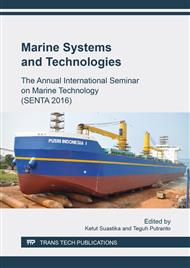p.155
p.165
p.174
p.181
p.189
p.199
p.207
p.215
p.221
Technical and Economic Analysis of Conversion Landing Craft Tank (LCT) into RO-RO Ferry for Route of Ketapang-Gilimanuk
Abstract:
Landing Craft Tank (LCT) is not allowed to operate as a ferry based on decree of Directorate General of Civil Ashore of No. SK 881/005/AP. DRJD/2015 that had been issued on 15 March 2015. This research is intended to analyze in technically and economically on the conversion of LCT Putri Sritanjung that has been operated as a ferry in Ketapang Port into RO-RO Ferry. The technical analysis is aimed to modifying this ship based on decree of Ministry of Transportation of no. 80 and no. 39, compliance of longitudinal strength, freeboard, tonnage, and stability. From this analysis, generate the longitudinal bending stress of 1, 248.957 kg/cm2, the minimum freeboard of 0557 metres with maximum draft of 2.19 metres, the tonnage of 551 GT, as well as the stability comply the criteria of Intact Stability (IS) Code in all loadcase. Meanwhile the economic analysis generate the total cost of conversion approximately 2,000,640,524 rupiahs.
Info:
Periodical:
Pages:
189-195
Citation:
Online since:
January 2018
Authors:
Keywords:
Price:
Сopyright:
© 2018 Trans Tech Publications Ltd. All Rights Reserved
Share:
Citation:


